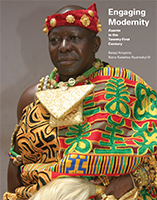
Engaging Modernity: Asante in the Twenty-First Century
Skip other details (including permanent urls, DOI, citation information): This work is licensed under a Creative Commons Attribution-NonCommercial-NoDerivatives 3.0 License. Please contact [email protected] to use this work in a way not covered by the license.
For more information, read Michigan Publishing's access and usage policy.
Ɛmena ne Kɔkɔsɛsɛ
Nana Kwame Mensah Bonsu
Otumfoɔ Ahenenananomhene
Ɛmena ne Kɔkɔsɛsɛ are two separate items. The former came first and it is made out of elephant tail and the latter is from ostrich feathers. The ostrich is commonly known as sohori but the formal Twi name is kɔkɔsɛsɛ. It was not uncommon in the past for bugs (including bees, flies, etc.) to crawl or fly around the king during ceremonies and as a result, Asantehene Kusi Boadum (c 1750-1764) created these regalia items, ɛmena ne kɔkɔsɛsɛ for his grandchildren (and now, great great grandchildren) to whisk bugs away from him. Issues of trust are one of the reasons why he asked his grandchildren (instead of Ahenkwaa) to perform this duty, for in the days of Asantehene Kusi Boadum, it was critical to protect royal space with family members. In creating these regalia items, the king said: Kɔkɔsɛsɛ, ma sɛsɛ me ho ɔde ne ho ntakera atwa ne ho ahyia (Like the ostrich, he is protecting himself with his feathers). The feathers are dyed red, gold, green, and blue to symbolize the unpredictable mood of the king in a given moment. Like the abosomakotrɛ (the chameleon), people would normally see him in different colors. Currently they use these ɛmena to prevent the general public or individuals who may penetrate the Asantehene’s mpɛsua, a large circle of courtiers who are part of the Asantehene group in a procession. They served without a chief until Otumfoɔ Opoku Ware II created a stool for them and placed them under Akyɛmpimhene since he is traditionally his son. The Akyɛmpimhene is also head of the kyidɔm (Rear Guard of the Army) and like the ɛkyɛm, fɛntɛmfrɛm and other regalia items in his care, the Akyɛmpimhene is allowed to include the ɛmena ne kɔkɔsɛsɛ in his procession whenever he represents the Asantehene as part of his official duty. Since they are grandchildren of Asante kings, the custodians of the ɛmena ne kɔkɔsɛsɛ can occupy all of the ahenemma stools including the Akyɛmpim, Atipin, Hia, Worakɛse, and Akɔnfɛre. In procession, Ɛmena ne Kɔkɔsɛsɛfoɔ follow Ɛkyɛmfoɔ while the Afenasoafoɔ immediately follow them.





